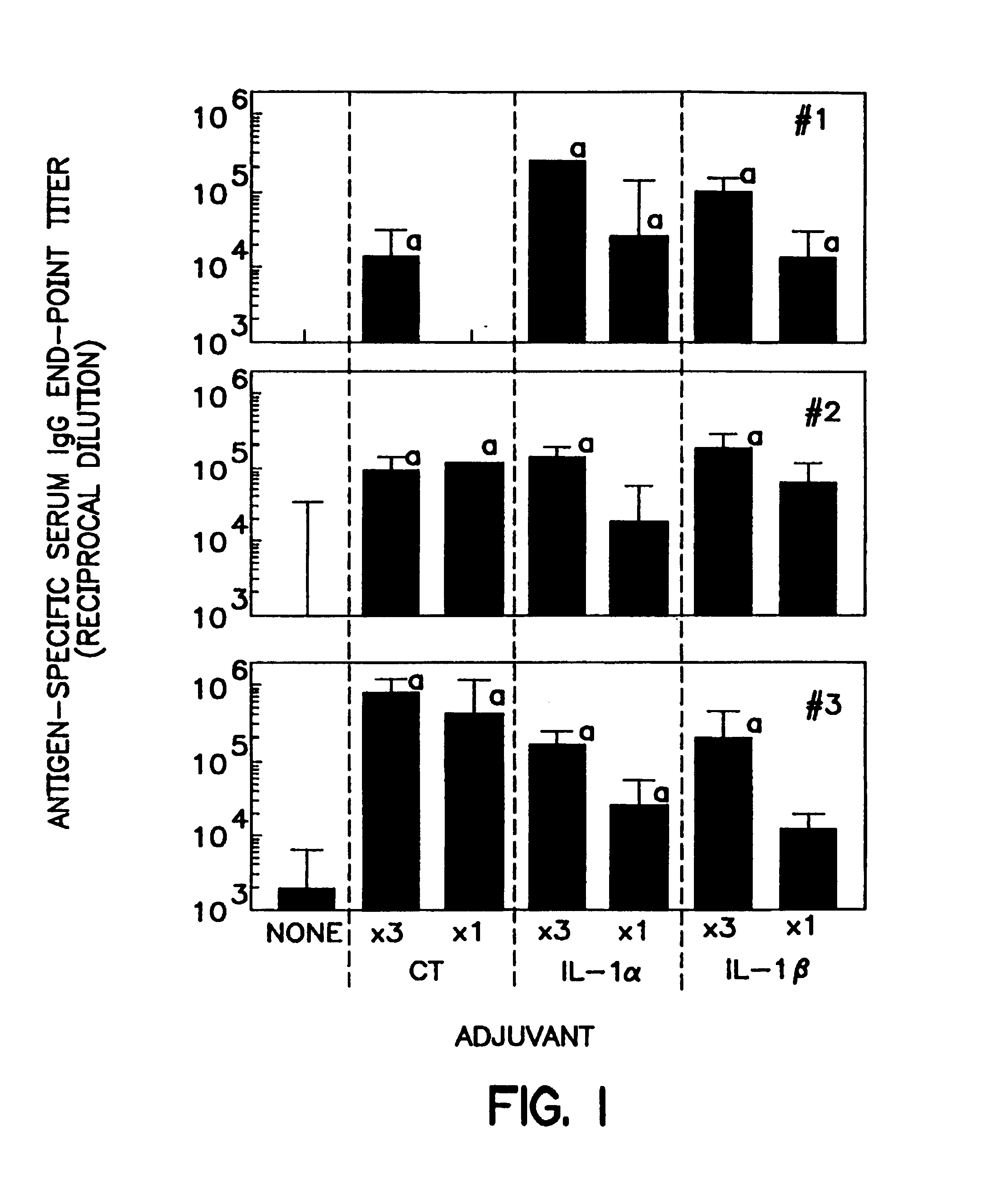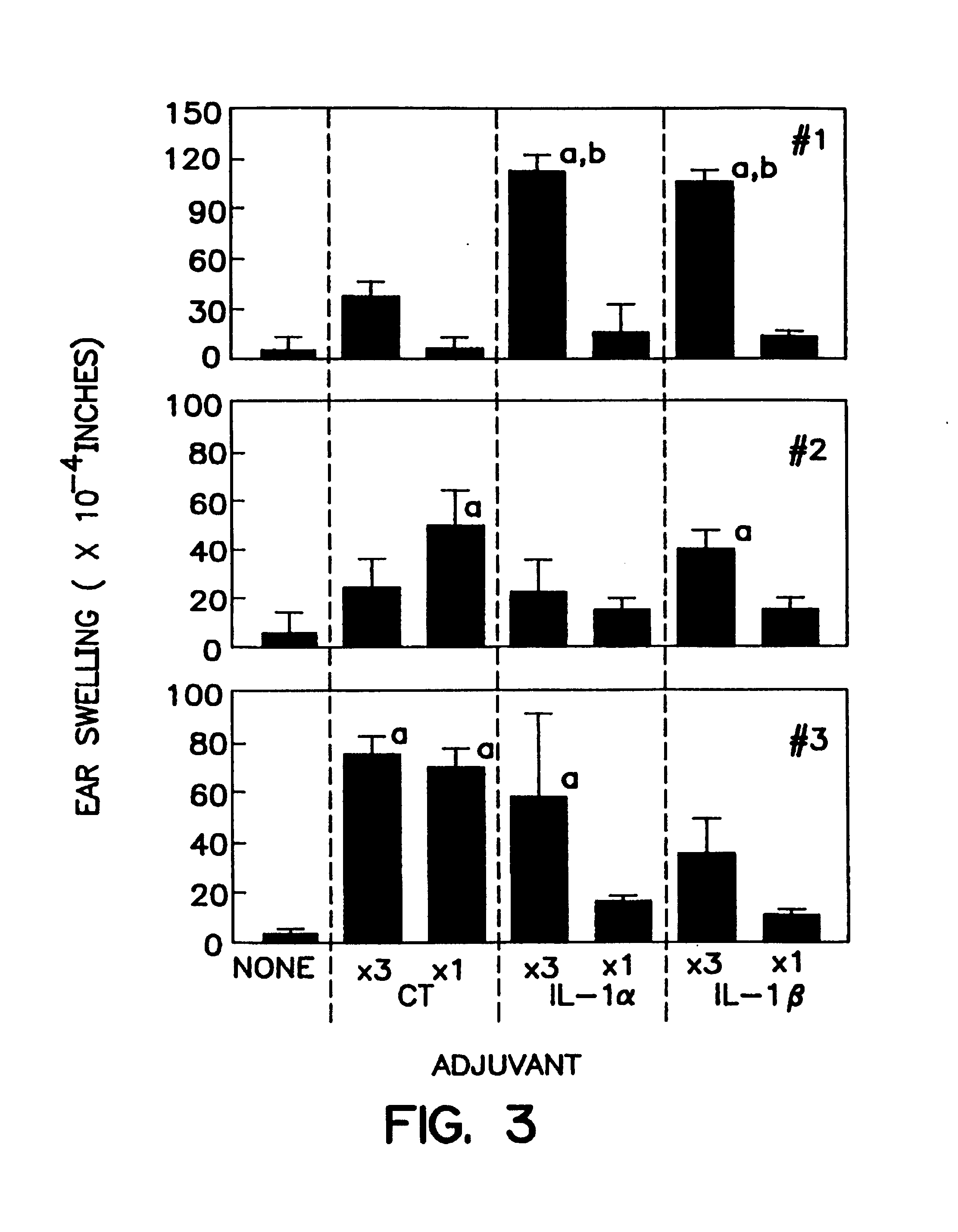Substantially non-toxic biologically active mucosal adjuvants in vertebrate subjects
a biologically active, vertebrate technology, applied in the direction of antibody medical ingredients, drug compositions, immunological disorders, etc., can solve the problems of unresolved oral or mucosal tolerance of antigens, unsafe use of ct as mucosal adjuvant in humans, and unsafe mucosal adjuvant use in humans, etc., to achieve safe and effective mucosal adjuvant, easy formulation, and oral tolerance in mucosal immunization
- Summary
- Abstract
- Description
- Claims
- Application Information
AI Technical Summary
Benefits of technology
Problems solved by technology
Method used
Image
Examples
example 1
IL-1α and IL-1β As Mucosal Adiuvants
MATERIALS AND METHODS
[0097]Animals
[0098]Female BALB / c and C57BL / 6 mice, 16-18 grams, were purchased from Frederick Cancer Research and Developmental Center, National Cancer Institute, Frederick, Md. Animals were housed in filter top cages and provided food and water ad libitum. All procedures for use and care of mice were approved by Duke University's Institutional Animal Care and Use Committee.
[0099]Immunization
[0100]Mice were intranasally immunized as previously described, Staats et al., J Immunol 157:462 (1996); Porgador et al., J Immunol 158:834 (1997); Staats et al., AIDS Research & Human Retroviruses 13:945 (1997). Briefly, mice (3-4 mice per group) were intranasally immunized with the indicated concentration (Table 2) of ovalbumin (#A-5503 SIGMA, St. Louis, Mo.) or tetanus toxoid (graciously provided by Dr. John Eldridge, Wyeth-Lederle Vaccines and Pediatrics) and the indicated adjuvant in a total volume of 15 μl (7.5 μl / nostril). The m...
example 2
Synthetic IL-1B Peptide as a Mucosal Adiuvant
[0135]Recombinant interleukin 1β and the synthetic IL-1β peptide 163-171 each possess mucosal adjuvant activity in accordance with the methods of the present invention. In this Example, BALB / c female mice were purchased from Charles River Laboratories and divided into groups of three to four (3-4) mice per group. All mice were intranasally immunized with 100 μg ovalbumin in distilled water in a total volume of 15 μL (7.5 μL per nostril). A total of five groups was used to test the adjuvant activity of IL-1α, IL-1β, and the IL-1β peptide as compared to the adjuvant activity of cholera toxin (Table 4). Mice were immunized a total of three times a week at two week intervals (day 0, day 14, and day 28). Serum was collected at day 35 and assayed for the presence of anti-ovalbumin lgG with ELISA, as described above. DTH responses were measured on day 42 by injecting 10 μL of sterile PBS into the left ear pinna and 10 μL of sterile PBS containin...
example 3
Use of IL-15 and GM-CSF as Mucosal Adiuvants
[0138]In accordance with the methods of the present invention, IL-15 or GM-CSF were admixed with 100 μg C4-V4 Roman IIIB HIV peptide vaccine (contains T-helper, V-cell and CTL epitopes) and delivered intranasally to BALB / c mice on day 0, 7, 14, and 21. Control mice received peptide only (negative control) or peptide and cholera toxin (positive control). Serum was collected on day 28 and tested for the presence of anti-C4-V3 IIIB lgG. Both IL-15 and GM-CSF served as mucosal adjuvants as indicated by the detection of antigen-specific serum lgG responses of 1:16,384 for both IL-15 and GM-CSF groups as compared to undetectable serum lgG responses in the negative control group and titer of 1:41,285 in the positive control group.
[0139]To determine if IL-15 or GM-CSF could enhance the immune response induced by intranasal immunization with peptide and CT, mice were immunized with peptide, CT and IL-15; or peptide, CT, and GM-CSF. The combination ...
PUM
| Property | Measurement | Unit |
|---|---|---|
| weight loss | aaaaa | aaaaa |
| volume | aaaaa | aaaaa |
| volume | aaaaa | aaaaa |
Abstract
Description
Claims
Application Information
 Login to View More
Login to View More - R&D
- Intellectual Property
- Life Sciences
- Materials
- Tech Scout
- Unparalleled Data Quality
- Higher Quality Content
- 60% Fewer Hallucinations
Browse by: Latest US Patents, China's latest patents, Technical Efficacy Thesaurus, Application Domain, Technology Topic, Popular Technical Reports.
© 2025 PatSnap. All rights reserved.Legal|Privacy policy|Modern Slavery Act Transparency Statement|Sitemap|About US| Contact US: help@patsnap.com



